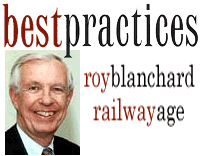|
At 130 carloads per mile per year the Eastern Idaho enjoys 13% better density than the average shortline, 72% more carloads per locomotive, and 78% more carloads per employee. |
 he
"Express Lane" perishables service offered by Union Pacific
and CSXT shows what can be done with the right kind of shortline relationships.
Roughly 12,000 carloads a year – almost half the total traffic originated
– comes off shortlines, according to Warren Wilson, head of the UP shortline
group. Here’s how it works on the highest volume shortline, the Eastern
Idaho Railroad (EIRR), and what its success means for other shortlines.
he
"Express Lane" perishables service offered by Union Pacific
and CSXT shows what can be done with the right kind of shortline relationships.
Roughly 12,000 carloads a year – almost half the total traffic originated
– comes off shortlines, according to Warren Wilson, head of the UP shortline
group. Here’s how it works on the highest volume shortline, the Eastern
Idaho Railroad (EIRR), and what its success means for other shortlines.
Express Lane was initiated in April 2000 for produce from the San Juaquin Valley to NYC and Boston with 8th and 9th morning deliveries respectively. Rates were set at a significant discount to the equivalent truck rate. By August 2000 UP had included Pacific Northwest origins for onions, fruits and frozen foods while CSXT added eastern destinations, all with roughly the same transit time commitments.
The Eastern Idaho is a member of the Watco family of eight shortlines (www.watcocompanies.com) based in Pittsburg, Kansas. The 270-mile EIRR is the result of one of the largest UP spin-offs and now handles some 35,000 carloads a year concentrated in food and agricultural products. At 130 carloads per mile per year the railroad enjoys 13% better density than the average shortline, 72% more carloads per locomotive, and 78% more carloads per employee.
UP first approached EIRR about Express Lane participation in the summer of 2000. Eastern Idaho interchanged with UP at either Minidoka or Idaho Falls, ID. The biggest obstacle, however, was customer acceptance. Says Jim Hanrahan, EIRR Marketing Manager, "The customers didn’t believe we could beat the trucks in landed cost and timeliness. ‘Show me,’ they said."
And so the shortline, UP and CSXT did. The UP sales staff pitched in and they got the support of the Idaho Potato Growers Assn. They arranged for split deliveries of individual carloads so that not every consignee had to deal with a whole carload at once. EIRR and UP signed an Express Lane agreement in Oct 2000 and as the skeptics became convinced the rails were for real the potato business came back at an accelerated pace.
Two critical keys to success are seamless interchange and empty car management. The first requires a signed and measurable Interline Service Agreement (ISA). Minimizing shortline dwell time is essential because EIRR contractually shares in the penalty for any delayed cars, and the longer the delay the bigger the fine. This is only fair since UP is hit with a cash penalty for late availability at destination.
A second aspect of seamless interchange is data integrity. Woody Sutton, VP- Manifest Products at UP, told me during a recent visit to Omaha that cars on the interchange without corresponding waybills in the UP local conductor’s work list may not get picked up. However, when the customer triggers a waybill either with the shortline directly or via the internet at www.myuprr.com the paperwork precedes the car. Moreover, the waybill starts the trip plan process and the sooner it begins the sooner the load is assigned to the right train out of North Platte.
Which leads us to the second point: car supply. Sutton assures me every piece of refrigerated equipment is booked well in advance. Delays in the empty return may not draw the same customer attention as loads, however an empty delayed is a load (and revenue) delayed. For this reason alone UP is ahead of most class 1s in assigning trip plans for empty cars and EIRR has a role in that process as well.
Says Sutton, "There is no doubt that the reefers have a longer cycle time empty than loaded. UP understands that it must tighten the overall cycle time of the fleet to justify reinvestment. Our focus in the coming year will be more pre-tripping at shipper's facilities, and, with our short line partners, triangulating moves warehouse to warehouse (unloading and loading at the same dock, different products in the same car, even simultaneous handling of inbound and outbound)."
Express Lane works because UP and CSXT identified an opportunity in perishable foods and committed the resources to win back roughly $200 mm in revenue thus far. That nearly half of the origins are on shortlines gives testament to their seamless win-win partnerships with the connecting class 1 railroad. Even with the initial customer resistance and skepticism the UP-EIRR team ultimately proved its worth.
Doing so consistently takes planning, perseverance, and performance measurement. Is your shortline a player?
